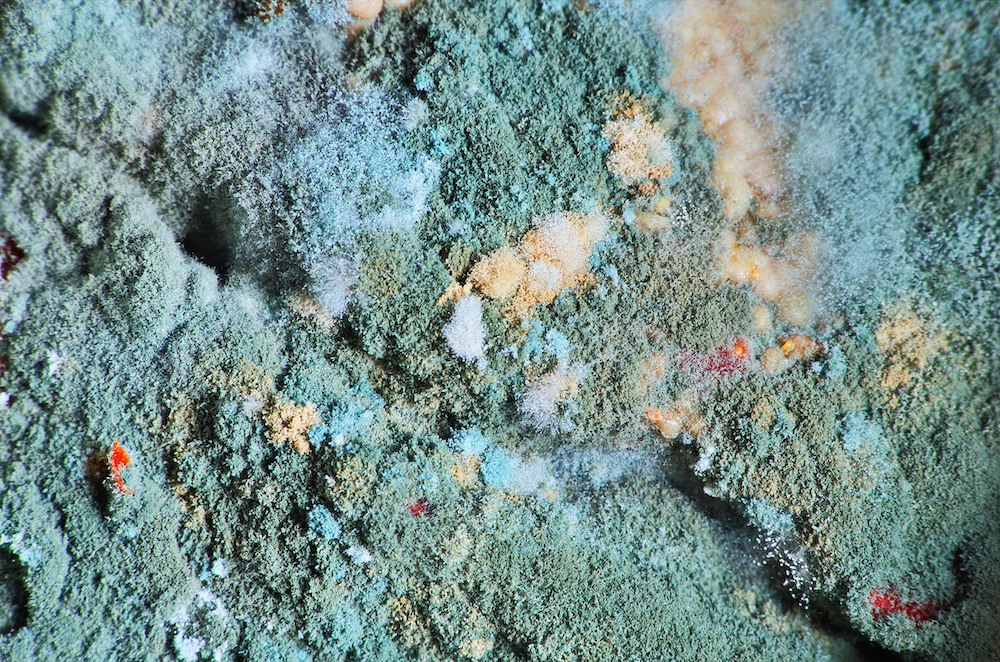This is one area where you don't want any spooky surprises!
We're all familiar with the common horror monsters: werewolves, vampires, and ghosts. Those of us who are especially into horror movies might recognize more niche antagonists: your Nosferatus, Brides of Frankenstein, and The Thing(s)—but comparatively few people know about the real-life monster that could very well be growing on your pipes, at this very moment. In honor of Halloween season (and as a reminder to check your pipes!), let's take a look at some of the most common real-life plumbing monsters, starting with:
Aspergillus

Courtesy of Shutterstock
This is the most common mold in America, with over 185 documented species! Although different species can appear in different textures and colors, Aspergillus is identifiable by long, flask-shaped spores that can quickly form thick layers on walls or carpets when left alone. As a result, it's a good idea to check both under your sinks and around your water heater every few weeks to ensure that nothing unwanted is growing there.
If left unaddressed, Aspergillus can cause some pretty nasty allergies, which can compound into asthma attacks and lung infections!
Acremonium

Courtesy of Shutterstock
This toxigenic mold might look simple harmless, but it's far from it. Acremonium is a unique form of mold because it changes appearance pretty significantly over its life cycle; starting first as a small moist mold that turns into a super fine powder after enough time. Exposure to acremonium has been linked to bone marrow diseases, along with immune system issues as well. It's also carcinogenic, which means it comes with elevated cancer risk and might potentially impact brain functions.
Acremonium is most frequently found in household systems that cycle water through an enclosed space, such as humidifiers, drain pans, cooling coils for refrigerators, and within the corners of sealed windows.
Chaetomium

Courtesy of Shutterstock
You can identify this mold by its cotton-esque texture and coloration. Chaetomium starts as a patch of fuzzy white mold before darkening over time, becoming pitch-black if left alone for long enough. This mold is typically caused by unaddressed leaks from roofs and/or sinks, making it extra important to check under your kitchen and bathroom sinks every once and a while. IF you have any water damage, repair it sooner rather than later to ensure you don't have to deal with mold removal down the line.
Penicillin

Courtesy of Shutterstock
While this type of mold is vital for manufacturing antibiotics, it can also be an incredibly unpleasant allergen if it starts growing in your home. Penicillin is often caused by water damage and grows in areas like carpets, wallpapers, and ducts. It's easy to identify by its bright blue (or greenish) surface and fuzzy texture. As it's commonly a result of water damage, it's important to fix any leaks as soon as they're identified to minimize the risk of a penicillin cluster growing.
If left alone for long enough, penicillin spores can become airborne, which causes even more problems. In addition to spreading easier, becoming airborne also increases the risks of it being inhaled—and causing allergic reactions!
Stachybotrys

Courtesy of Shutterstock
If you need any indicator of how serious Stachybotrys is, remember, it's THE black mold you've no doubt heard people talk about. In addition to causing potentially severe health problems in anyone who inhales it, black mold can also grow in a variety of different places. This highly toxic mold thrives in damp, dark areas, especially in high humidity.
In the event you find black mold in your home—or suspect it might be there—it's important to remove any children from the household immediately and reach out to a mold removal specialist to identify what your next steps are. Unlike dealing with vampires and werewolves, dealing with mold is something most people will probably have to do at some point in life.
While you may be able to throw away any materials that are infested with mold, it can be difficult to completely remove a source of infestation without a professional eye. Additionally, fixing mold problems isn't as easy as simply removing whatever drywall or tile is infested—it also means addressing whatever water source cultivated the mold in the first place.
Although mold can be unpleasant (and sometimes dangerous) it doesn't have to be terrifying. Be diligent about the areas around your pipes, sinks, and humidifiers, and don't hesitate to call the pros if you suspect that something fuzzy is growing down there.
